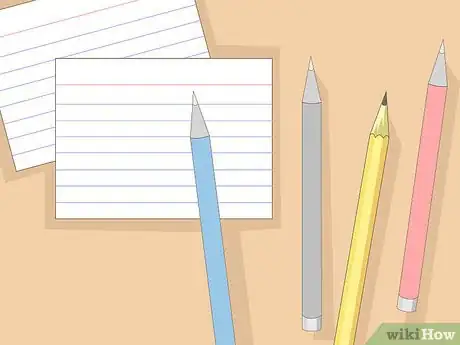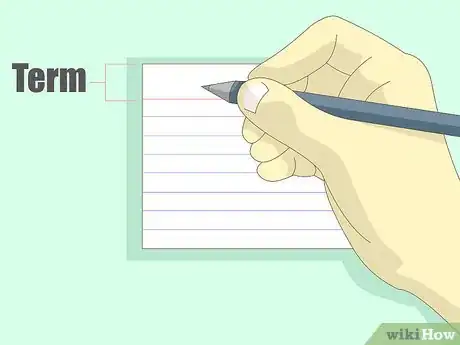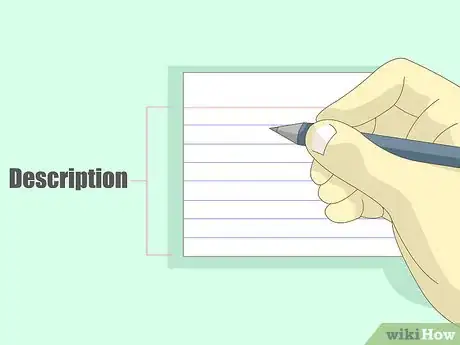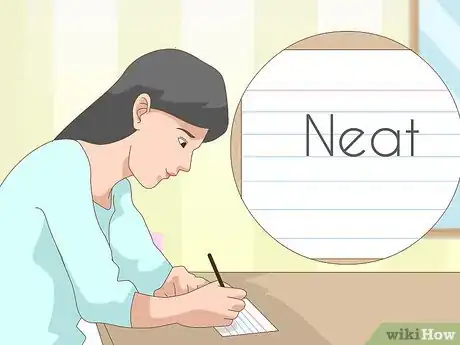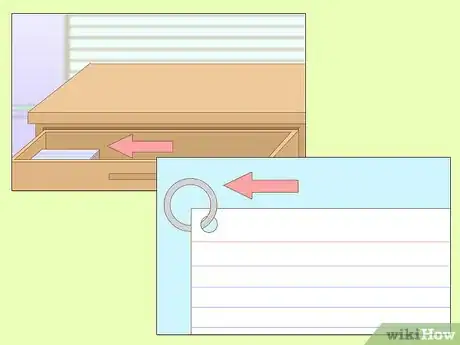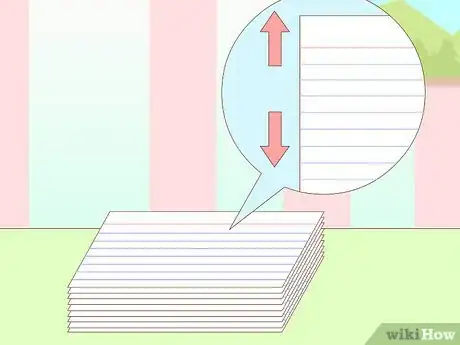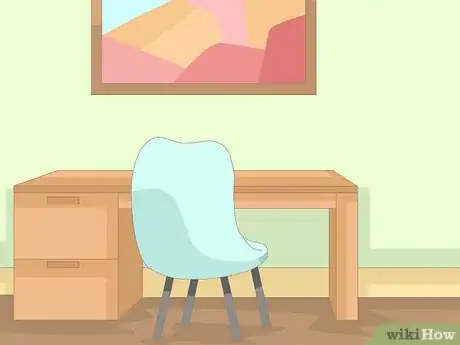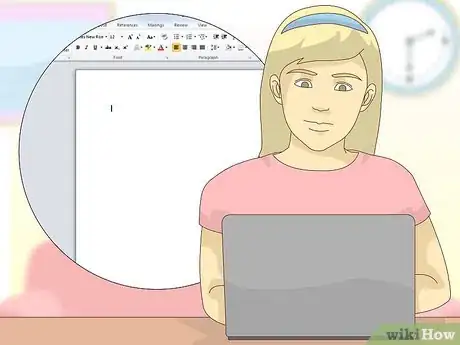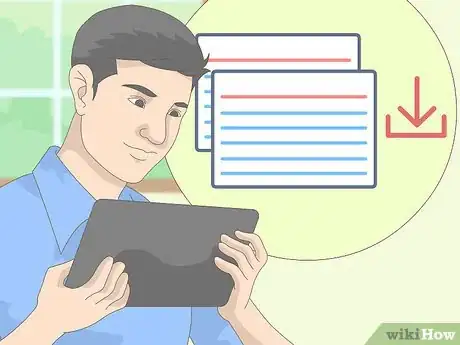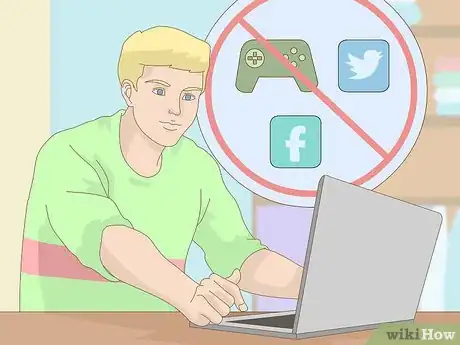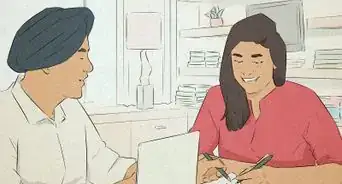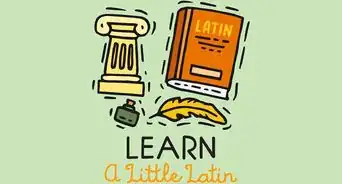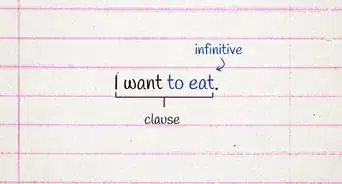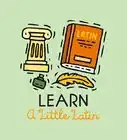This article was co-authored by Christopher Taylor, PhD. Christopher Taylor is an Adjunct Assistant Professor of English at Austin Community College in Texas. He received his PhD in English Literature and Medieval Studies from the University of Texas at Austin in 2014.
This article has been viewed 50,373 times.
Index cards are a classic study tool you can use to memorize vocabulary words for a test or quiz. Making index cards is a fairly simple process. After creating your cards, you can organize them to help you study effectively. You can also use technology to assist you in creating index cards to help bolster your study habits.
Steps
Creating Your Flashcards by Hand
-
1Gather your supplies. In order to make flashcards by hand, you should first gather your supplies. You can get most of the supplies you need at a local department store. You may also find some materials at an office supply store.
- You will need index cards, which are 3 by 5 inches (7.6 by 12.7 cm) cards on which you'll be writing your vocabulary terms.
- You'll need a pen and a pencil. It's a good idea to write the cards down in pencil first, in case you misspell something, and then trace over them in pen so they're clear and easy to read.
- Consider investing in several different colors of pen. This way, you can color-coordinate your cards by subject or unit. Choose colors you can easily read, however. Something written in yellow ink may be hard to make out, while something written in blue or red is easily readable.
EXPERT TIPChristopher Taylor is an Adjunct Assistant Professor of English at Austin Community College in Texas. He received his PhD in English Literature and Medieval Studies from the University of Texas at Austin in 2014.English Professor
 Christopher Taylor, PhD
Christopher Taylor, PhD
English ProfessorChristopher Taylor, Adjunct Assistant Professor of English, notes: "Flashcards are a great tool for memorizing vocabulary words! Put one word on the front of each card and the corresponding definition on the back of each card. Remember to write largely and legibly."
-
2Write down the vocabulary words on one side of the cards. Vocabulary index cards are very simple to make. To start, write down the vocabulary term on one side of each card. Usually, index cards have one lined side and one blank side. It's a good idea to write the vocabulary term on the blank side, as you can use the lines to guide your writing when you write down definitions.
- Write the words in pencil first and then write over them in pen.
- Color coordinate the cards as needed. For example, all the vocabulary from English class can be written in red. All the vocabulary from history class can be written in blue. This way, if the cards accidentally get jumbled, you can easily separate them again by subject.[1]
- You can also color coordinate by difficulty. For example, you could write the vocabulary words you already know in green, the tougher ones in red, and the extremely challenging ones in blue.
Advertisement -
3Write down the definitions on the other side. When you've written all the vocabulary words on the blank side of the cards, flip your stack over. Write down the definitions of the terms on the lined side of your index cards.
- Make sure you leave yourself enough room. Some words may have longer definitions. Try to write small for these words.
-
4Use neat handwriting. When writing index cards, try to use your best handwriting possible. You do not want your cards to be illegible and if you cannot read the definition for a particular word, your index cards will not be effective. Write slowly and neatly through all of your cards.
- Take breaks when necessary. If your hand begins to feel tired, this can affect the legibility of your handwriting.
- Limit how much you put on each card. Try to only write down one vocabulary word per card. Writing too small could cause your handwriting to become muddled and hard to understand.[2]
Organizing Your Cards
-
1Find a safe place to store the cards. Make sure you store your flashcards in a safe place. You want to store them somewhere where they'll stay in order and not get damaged and smudged.
- You can store index cards in your desk at school or at home. You can also keep them in a binder, folder, or empty pencil box. You may want to tie a rubber band around the index cards to keep them in place.
- You can also punch a hole in the top right or left corner of each index card. Then, you can purchase a metal ring, like you would use for a key ring, and place the cards through the ring. This will make them easy to flip through when studying and keep them in the order you want. One small downside to this method, however, is that you may want to reorganize the cards on occasion. Changing the order of things slightly when studying can help improve memory. It may be cumbersome to adjust the order of your cards if you have to remove them from a ring.
-
2Always stack cards in the same direction. When you finish using your index cards, make sure they're stacked in the same direction. For example, make sure the sides with the vocabulary words are pointed up while the sides with the definitions are pointed down. This way, you can more easily keep things consistent when you're studying.
-
3Divide the cards for separate study sessions. For effective studying, you should not try to cram everything into a signal session. It's recommended that you study 30 minutes to an hour at a time, with breaks in between. Organize your index cards to accommodate short study sessions.[3]
- Try to figure out how much vocabulary you can reasonably learn in an hour. For example, maybe you can set out to learn 10 words. Divide your cards into sets of 10.
- You may have to do some trial and error to figure out a good pace for you. You may find, for example, it takes you less than an hour to learn 10 words or that it takes you a lot longer. You can add more or less cards to the deck for your next study session.
-
4Store your cards in a designated study space. Where you study matters a lot in terms of effectiveness. When you're studying, you should bring all the materials you need and leave behind any unnecessary materials.[4] Try storing your index cards on your desk or workspace. This way, when you go there to study your cards will be there waiting.
Using Technology
-
1Type your index cards. If your handwriting is particularly bad, consider typing your cards on a word processor. You can print out pieces of paper with vocabulary words and definitions written on them. Then, you can cut out these chunks of texts and glue them on cards. Printed, typed index cards may be more effective as it lessens the risk of illegibility or misspelling.
- Some printers, however, may have a feature where you can print directly onto index cards. Check your printer's settings and see if this is possible.
-
2Get flashcards for your computer. There are many websites and softwares that allow you to create and print flashcards to use on your computer. If you don't mind reading and studying from a screen, this could be a great way to save time.
- Quizlet and StudyBeans are websites that allow you to create flashcards to use online by typing in the terms and definitions you need to memorize. The sites will then automatically generate flashcards you can use.[5]
- If you're studying vocabulary for the SAT, UnderGrad Flash is a computer program that contains flashcards and study guides for SAT vocabulary terms.[6]
- If you're studying vocabulary for the GRE, GradFlash and Kaplan GRE Vocabulary Exam Flashcards offer digital flashcards containing GRE words.[7]
-
3Look into downloading flashcards on a tablet or other device. If you have a Kindle, iPad, or a similar device, there are many applications and softwares you can purchase or download for free that can generate vocabulary flashcards. Websites like Quizlet and StudyBeans can easily be accessed and used through Kindle.[8]
- The main advantage to using a tablet over a regular computer is that you can take your tablet anywhere.
- You can also add images to the flashcards, as well as organize them by subject, unit, or study session using a tablet.
-
4Eliminate distractions when working from an electronic device. The major downside to using flashcards on a computer is the potential for distractions. You have access to the internet, as well as games, pictures, and so on. If you choose to use flashcards on a computer or portable electronic device, take steps to lessen distractions.
- Disconnect from the Internet, if you're able to use the flashcards without going online. In fact, it may be a good idea to go to a place where you cannot get a WiFi connection. This removes the temptation altogether.
- If you have to be online to access your flashcards, sign out of all social media accounts like Facebook and Twitter. You should also close any programs running in the background that may be distracting.
Expert Q&A
-
QuestionWhat size is an index card?
 Christopher Taylor, PhDChristopher Taylor is an Adjunct Assistant Professor of English at Austin Community College in Texas. He received his PhD in English Literature and Medieval Studies from the University of Texas at Austin in 2014.
Christopher Taylor, PhDChristopher Taylor is an Adjunct Assistant Professor of English at Austin Community College in Texas. He received his PhD in English Literature and Medieval Studies from the University of Texas at Austin in 2014.
English Professor Index cards are generally 3 x 5 inches or 4 x 6 inches. If you make them on a computer, you could create cards that are any size you want.
Index cards are generally 3 x 5 inches or 4 x 6 inches. If you make them on a computer, you could create cards that are any size you want. -
QuestionHow do you make cue cards?
 Christopher Taylor, PhDChristopher Taylor is an Adjunct Assistant Professor of English at Austin Community College in Texas. He received his PhD in English Literature and Medieval Studies from the University of Texas at Austin in 2014.
Christopher Taylor, PhDChristopher Taylor is an Adjunct Assistant Professor of English at Austin Community College in Texas. He received his PhD in English Literature and Medieval Studies from the University of Texas at Austin in 2014.
English Professor Stick to ONE major idea per card (do not write out a speech), write legibly and in a large hand (or font), number them, and have any key information (timing, props) marked somewhere on each card.
Stick to ONE major idea per card (do not write out a speech), write legibly and in a large hand (or font), number them, and have any key information (timing, props) marked somewhere on each card. -
QuestionHow do you make flashcards on Microsoft Word?
 Christopher Taylor, PhDChristopher Taylor is an Adjunct Assistant Professor of English at Austin Community College in Texas. He received his PhD in English Literature and Medieval Studies from the University of Texas at Austin in 2014.
Christopher Taylor, PhDChristopher Taylor is an Adjunct Assistant Professor of English at Austin Community College in Texas. He received his PhD in English Literature and Medieval Studies from the University of Texas at Austin in 2014.
English Professor If you want to use Word to make flashcards you will simply need to write the word and its definition on separate parts of the document. Then, print the document and fold it so the word is one side and the definition is on the other. Generally, making flashcards by hand or using a program like Quizlet would be easier.
If you want to use Word to make flashcards you will simply need to write the word and its definition on separate parts of the document. Then, print the document and fold it so the word is one side and the definition is on the other. Generally, making flashcards by hand or using a program like Quizlet would be easier.
References
- ↑ http://www.rrc.ca/index.php?pid=7710
- ↑ http://www.rrc.ca/index.php?pid=7710
- ↑ https://psychcentral.com/health/highly-effective-study-habits
- ↑ https://psychcentral.com/health/highly-effective-study-habits
- ↑ http://grammar.yourdictionary.com/for-students-and-parents/vocabulary-flashcards.html
- ↑ http://grammar.yourdictionary.com/for-students-and-parents/vocabulary-flashcards.html
- ↑ http://grammar.yourdictionary.com/for-students-and-parents/vocabulary-flashcards.html
- ↑ http://learnoutlive.com/create-flashcards-kindle/
